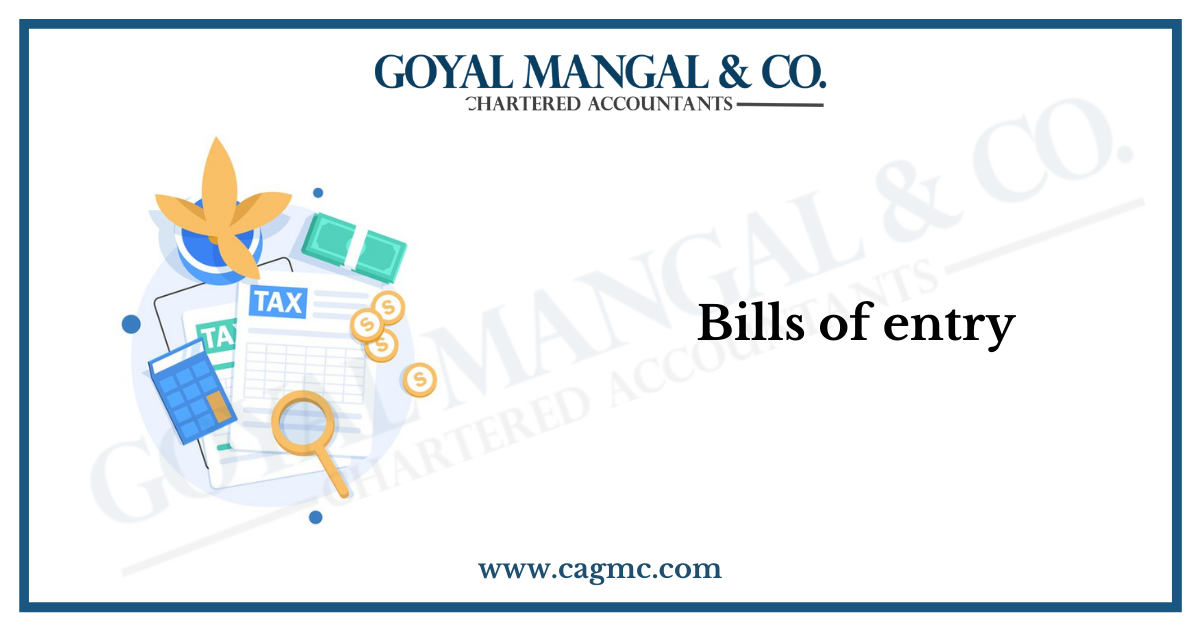| Table of Content |
It is a document showing the details of goods imported. The custom authorities determine the amount of import duty on this basis. It is important to fill up a bill of entry so that the goods can be cleared from the customs office along with other necessary measures. t is essential for the importer to hand over the bill of entry along with bill of lading and port trust dues receipt after paying the import duty to the shipping company for release of the goods.
When goods are imported into a country, customs duty has to be paid by the import importer prepares the Bill of Entry declaring the value of goods, quantity’ and description. This is prepared in triplicate. Customs authorities may ask the importer produce the invoice of the exporter, broker’s note and insurance policy to satisfy about the correctness of value of goods declared.

Goods Classification
Goods are classified into three categories,
- Free Goods: These goods are not subjected to any customs duty.
- Goods for Home Consumption: These goods are imported for self-consumption.
- Bonded Goods: Where goods are subject to customs duty, till duty is paid, goods are kept in Bond.
Contents of Bill of Entry
- Name and address of importer.
- Name and address of exporter.
- Import license number.
- Name of port where goods are to be cleared.
- Description of goods.
- Value of goods.
- Rate and value of import duty payable.
GST Bills of Entry
A Bill of Entry is a declaration form filled by the importer or his clearing agent with the Customs department.
For you to initiate the customs clearance formalities, a bill of entry must be filled along with other requisite documents on or before the arrival of goods. After that, the bill of entry is filled, and an authorized Customs Officer checks it. For it to clear, the importer must pay the Basic customs duty, IGST, and GST Compensation Cess.
If the Bill of Entry is not filled within the stipulated time of 30 days after the arrival of goods, then the cargo may be subjected to auction by the relevant authorities.
Import Procedure
- Arrival of goods and procedures prior to lodgement of goods
- Conveyances to call only at Notified Customs Ports / Airports
- Power to board conveyance, to question and to demand documents
- Delivery of Import Manifest
- General Conditions
- Amendments
- Penal Liability
- Entry Inwards
- Enclosures to Import General Manifest
- Procedure for filing IGM at Custom Houses operating EDI service centres
- Filing of Stores List
- Unloading and Loading of Goods
- Other liabilities of carriers
- Procedure for clearance of Imported Goods
- Bill of Entry – Declaration
- Assessment
- EDI Assessment
- Examination of Goods
- Green Channel facility
- Payment of Duty
- Amendment of Bill of Entry
- Prior Entry for Bill of Entry
- Mother Vessel/Feeder vessel
- Specialised Schemes
- Bill of Entry for Bond/Warehousing
Types of Bills of Entry
There are three types of bills of entry procedures in India:
- Bill of entry for home consumption:
This bill of entry is in white color, before introduction of electronic media of filing. Manual bill of entry is filed, where in no electronic data interchange is available to file bill of entry electronically. Importer files bill of entry for home consumption wherein he wants to clear the goods on payment of duty or free duty goods to remove the cargo to his premises immediately. As per customs department section 46 of the customs Act 1962 describes in detail about the procedures and formalities.
- Warehousing Bill of Entry
Warehousing bill of entry is also called Into Bond Bill of Entry. This is in buff color before introduction of EDI filing, if filed manually where in no electronic filing available. As per section 46 and section 60 of Indian Customs Act describes in detail about this type of filing. If an importer does not want to pay duty on his goods immediately up on arrival of goods at port, he keeps his goods in a customs bonded ware house by following formalities under such provisions and files into bond bill of entry. He pays duty and takes the quantity of goods as and when he requires
- Ex-bond Bill of Entry:
The ex-bond bill of entry is filed to take the goods for home consumption by importer as and when he requires from the bonded warehouse explained above. The ex-bond bill of entry is in green color before if filed manually where in no EDI facility is available. The details of these types of procedures are mentioned in section 68 of Indian Customs Act.


